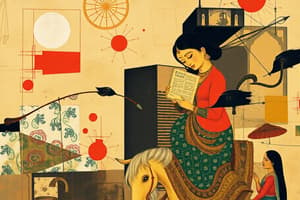Podcast
Questions and Answers
What is the approximate period when the painting was created?
What is the approximate period when the painting was created?
- 1700-1710 A.D.
- 1750-1760 A.D. (correct)
- 1800-1810 A.D.
- 1780-1790 A.D.
The painting 'Radha (Bani Thani)' is a Rajasthani school of miniature painting.
The painting 'Radha (Bani Thani)' is a Rajasthani school of miniature painting.
True (A)
The painting 'Radha (Bani Thani)' is made on ________ with water colour in tempera technique.
The painting 'Radha (Bani Thani)' is made on ________ with water colour in tempera technique.
hand made paper
What is the name of the artist who created the painting 'Radha (Bani Thani)'?
What is the name of the artist who created the painting 'Radha (Bani Thani)'?
What is the name of the king who was a great devotee of Radha and Krishna?
What is the name of the king who was a great devotee of Radha and Krishna?
The painting is divided into three parts.
The painting is divided into three parts.
What is the meaning of 'Bani Thani'?
What is the meaning of 'Bani Thani'?
The eyes and faces of both Krishna and Radha in the painting betray ____________ and pain.
The eyes and faces of both Krishna and Radha in the painting betray ____________ and pain.
Match the following elements of the painting with their descriptions:
Match the following elements of the painting with their descriptions:
The painting is made using oil colours.
The painting is made using oil colours.
Flashcards
Rajput School of Painting
Rajput School of Painting
Another name for the Rajasthani School of Painting.
Bold lines and contrasting colors
Bold lines and contrasting colors
A key feature of Rajasthani paintings: strong lines and vibrant hues.
Themes of Rajasthani Painting
Themes of Rajasthani Painting
Common themes in Rajasthani paintings: seasons, music modes (Ragamala), and religious stories.
Mewar School
Mewar School
Signup and view all the flashcards
Maru Ragini
Maru Ragini
Signup and view all the flashcards
Jaipur/Amber School characteristics
Jaipur/Amber School characteristics
Signup and view all the flashcards
Dhundar School
Dhundar School
Signup and view all the flashcards
Sawai Pratap Singh
Sawai Pratap Singh
Signup and view all the flashcards
Marwar or Jodhpur School
Marwar or Jodhpur School
Signup and view all the flashcards
Kishangarh School
Kishangarh School
Signup and view all the flashcards
Study Notes
Rajasthani Miniature Painting
- Rajasthani School of Painting also known as Rajput School of Painting
- Flourished between 16th and early 19th century in princely kingdoms of Rajasthan and parts of Madhya Pradesh
- Rajput courts patronized painting, influenced by Mughal court practices
- Presence of painters from Mughal atelier in Bikaner, Jodhpur, or Kishangarh contributed to local Rajput schools
Characteristics of Rajasthani School
- Bold lines and powerful, contrasting colors
- Figures shown flat, with little attempt to depict perspective in a naturalistic fashion
- Painting surface sometimes divided into many compartments of different colors
- Influence of Mughals seen in refinement of drawing and introduction of some naturalism in figures and trees
Subject Matter
- Themes: seasons, Ragamala, hunting, religious themes from Ramayana and Mahabharata, love scenes of Radha and Krishna
- Portraits of kings and queens, highlighting societal values and improvements made by monarchs for the good of society
- Use of paper, ivory, and silk as canvas
Sub-Schools of Rajasthani Painting
Mewar School
- Also known as Udaipur school
- Characterized by powerful and rhythmic lines, glowing colors in deep harmonious contrast
- Examples: Maru Ragini by Sahibdin
Jaipur or Amber School
- Also known as Dhundar school
- Oldest evidence seen in Bairat wall paintings and palace walls of Amer palace
- Folk-style finish, despite Mughal-style attire and headdress
- Attained pinnacle during reign of Sawai Pratap Singh in 18th century
Marwar or Jodhpur School
- Jodhpur and Bikaner controlled by Rathods, Jaisalmer ruled by Bhati's
- Men and ladies wore brightly colored attire, followed Mughal traditions until 18th century
- Later, Rajput element grew more prominent, with linear rhythm and bright colors
- Examples: Chaugan Players by Nooruddin
Kishangarh School
- Characterized by fine draftsmanship, technical execution, and use of softer tones of colors
- Examples: Radha (Bani Thani) by Nihal Chand
Studying That Suits You
Use AI to generate personalized quizzes and flashcards to suit your learning preferences.




